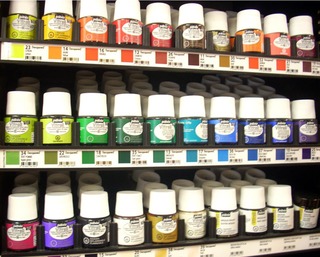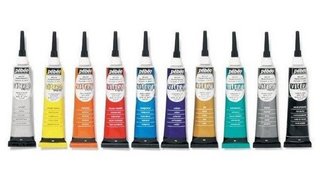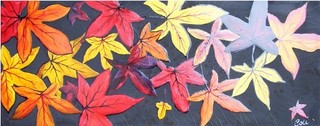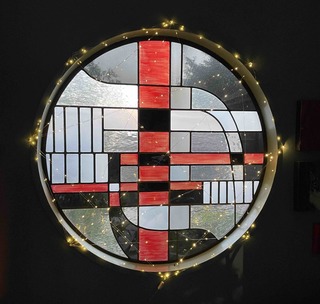What are Glass Paints and How to Use Them
As a versatile mixed media artist working in the vibrant art scene of Hamilton, New Zealand, Collette Fergus, who also worked at a well-known art shop in the city in the distant past, has had the privilege of exploring the fascinating world of glass paints.
Her artistic journey with these paints has not only manifested in her unique hand-painted Boozehag wine glasses but has also found its place in her mixed media creations, imparting a remarkable high-gloss, transparent, and glassy finish to her works.

Pebeo Glass Paint Range pictured above
Pebeo Glass Paints: Elevating Artistry
Collette's preferred choice for glass paints includes the Pebeo Vitrail Glass Paint and Pebeo Vitrea 160 Glass Paint, which she conveniently sources from reputable outlets like Gordon Harris and Spotlight. These paints open up a world of possibilities for artists seeking to infuse glass and metal surfaces with vivid, transparent hues.
- Vitrea 160: This range boasts an impressive selection of 30 transparent colours, available in glossy and frosted versions. These water-based colours are renowned for their professional quality and ease of use.
- Vitrail: With 26 transparent, luminous colours at its disposal, the Vitrail range offers artists unparalleled brilliance and versatility. The interminable colours enable artists to craft their unique shades, adding an extra layer of creativity to their work.
Collette highlights a crucial distinction between these two paint lines. While Vitrea 160 is water-based and requires baking in an oven for permanence, Vitrail is a solvent-based glass paint that should never be baked due to the flammable solvents.
Once dry, Vitrail paints are permanent, making them ideal for extensive projects such as glass doors or windows that cannot undergo the baking process.
Baked Vitrea 160 paints are dishwasher safe, ensuring durability for functional items like drinking glasses, plates, and jugs. However, Collette advises against using a dishwasher, as she has experienced paint peeling off in such conditions.
The air-dry colours suffice for decorative pieces like vases or ornaments. However, baked options offer a more comprehensive array of colours. Additionally, artists can explore Liquitex Glossies, which are air-drying paints that can also be baked for increased durability.
Application Techniques for Glass Paints
To make the most of these versatile paints, artists should ensure their surfaces are impeccably clean and free from any coatings that might hinder paint adhesion. Collette suggests using brushes or sponge applicators for smooth application and stencils or patterns for those who prefer guidance in their designs.
Transfers and tracing paper can streamline the process of creating intricate designs on opaque surfaces like coffee mugs or plates.
The slow-drying nature of glass paints allows for marbling effects if colours are carefully swirled together. Furthermore, artists can experiment with outliner pens that create a 3D raised line effect reminiscent of stained glass windows.

Pebeo Outliners
These pens are compatible with the Vitrea 160 paints and can be used to outline designs before filling them in with colour. It's crucial to allow the outline to air dry for 24 hours before baking in the oven.
Many glass paint ranges also offer paint marker pens for quicker and easier application. Pebeo's Vitrea 160 liner range, for instance, includes a variety of glossy and frosted colours in both bullet tip markers and fine liners, making them suitable for detailed work, writing, and quick projects. These markers, like the paints, become durable after baking.
Helpful Tips for Glass Painting Success
Collette shares some invaluable tips for achieving the best results with glass paints:
- Cleanliness: Ensure the glass is impeccably clean before painting.
- Follow Instructions: Carefully read and follow the instructions for the selected paint product, including any required undercoats or overcoats.
- Baking: If baking, preheat the oven to the desired temperature with the glass inside. Use a timer to bake for the recommended time and allow the piece to cool before removing.
- Correcting Mistakes: If a mistake is made, promptly wipe it off before baking, using warm water or alcohol.
- Brush Care: Clean brushes and tools with soap and water immediately after use to prevent paint from drying and becoming permanent.
- Sponges: Use sponges for even coverage when painting large areas.
- Experiment: Explore various mediums, accessories, and auxiliary products to achieve different effects, such as frost or iridescence.
- Avoid Interbrand Mixing: Mixing paints from different brands is discouraged as each has a unique formulation that may lead to unintended results.
Collette's artistic journey with glass paints is a testament to their endless creative possibilities. When used thoughtfully and with the proper techniques, these paints can transform everyday objects into works of art, adding a touch of brilliance and sophistication to any artist's repertoire.

'Rich Season' a mixed media painting using glass paint by Collette Fergus
Note: The main image is of the stained glass window in Collette's home. Its a beautiful designer piece but she didnt like the choice of baby pink glass in it so she painted it red with glass paints. This photo was taken 20 years on and it's still doing well. Collette used the Pebeo Vitrail air dry glass paints as she obviously couldnt put the window in the oven!
Check out Collette's other articles on artistic pursuits, including Yarn bombing and Sun painting too
Posted: Wednesday 17 March 2010
